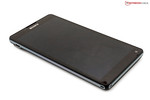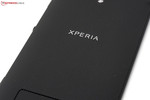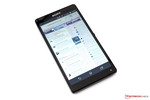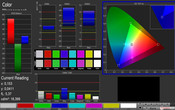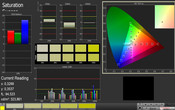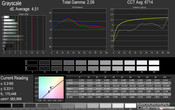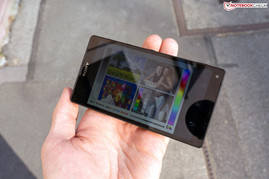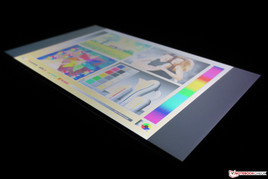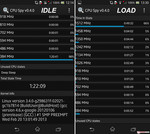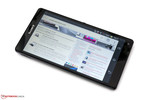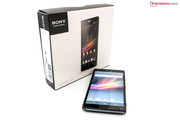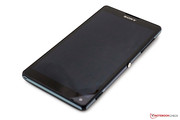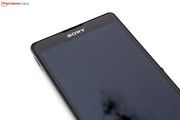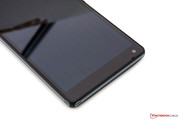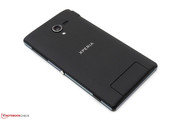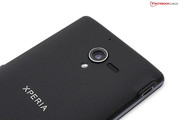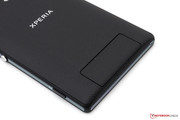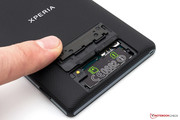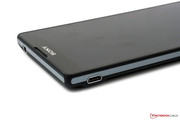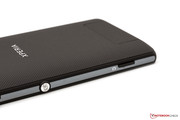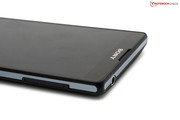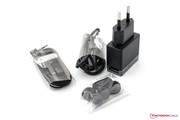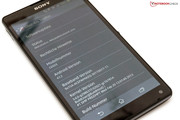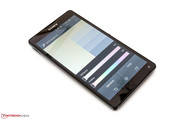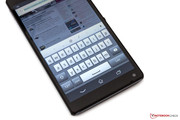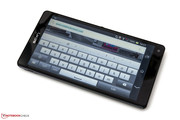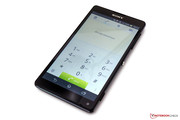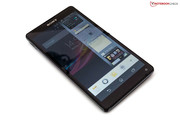Review Sony Xperia ZL Smartphone

For the original German review, see here.
One flagship smartphone does not seem to be enough for Sony, since the Japanese manufacturer is providing another high-end smartphone in the form of the Xperia ZL that is based on the previously tested Xperia Z and shares the same hardware. At the heart of the device, a Qualcomm Snapdragon S4 Pro System-on-a-Chip (SoC) with four cores and the Adreno 320 integrated graphics unit carries out the processing tasks, while the 5-inch capacitive Full-HD display has a resolution of 1080x1920 pixels. Additional features include 16 GB of internal memory, 2 GB of RAM, high-resolution cameras and a micro SD card reader.
The design meanwhile is different from the Xperia Z, nevertheless a common philosophy is still recognizable. The structure on the back of the device and the readily accessible interfaces immediately caught our attention, whereby Sony have forgone the dust and water protection. We will take a detailed look at the Xperia ZL in this review, and determine whether the current price of 550 Euros (~$715) makes this device a good choice.
Due to the similarities with the Sony Xperia Z we will omit identical aspects in this review, and refer readers to the review of the Sony Xperia Z.
Case
Upon unpacking the device, the differences in design of the case compared to the Xperia Z are the first things that stand out. While the sides with their reflective inlays are identical, the back of the device has a textured surface and rounded edges helping it to lie better in the hand than its counterpart with its relatively straight edges. Of course, the surface made of plastic does not make as good an impression as the one made of premium glass, but on the bright side, the latter solution is also far more sensitive even with a protective layer. The front of both smartphones is the same, whereby the display is surrounded by a black glass that is covered with a protective layer upon delivery. Along with the black version reviewed by us, the Xperia ZL is also available in the colors red and white.
The manufacturing quality and solidity of the case left a good impression. The back, made of plastic, is less impressive, but the pleasant haptics are another matter. Unfortunately, the cover cannot be removed, which means that access to the battery is not possible. Behind a small panel on the back it is possible to find the micro SIM slot and the micro SD reader. Compared to the Xperia Z the newer Xperia ZL is not protected from dust and water; a small difference that requires a bit more caution during daily use.
With a size of 69.8 x 131.7 x 9.8 millimeters (~2.75 x 5.19 x 0.39 inches/W x H x D) and a weight of 151 grams (~5.3 ounces) the Xperia ZL is somewhat shorter than the Xperia Z, but on the other hand it is also marginally thicker and five grams (~0.2 ounces) heavier. Operating the device with a single hand is not a problem, although people with small hands could encounter some difficulties reaching the outer edges of the display, which is why we would recommend trying it for yourself before making the purchase.
Connectivity
The Sony Xperia ZL has 16 GB of flash memory integrated as standard, although only 11.11 GB (69%) are available to users - an acceptable amount. Using the micro SD card reader it is furthermore possible to expand this relatively easily. During our practical test, we did not encounter any problems with using a 64 GB micro SD card.
For the purpose of taking photographs or making videos, the Xperia ZL has a main camera with a resolution of 13 megapixels, as well as a front camera with 2 megapixels. The quality of the images is reasonable. More than good snapshots should not be expected though. Further information regarding the image quality can be found in the review of the Sony Xperia Z.
The sides of the smartphone provide the usual interfaces. Data transfers and the power supply are both facilitated by the Micro USB port (specification 2.0). With a suitable MHL adapter available for less than ten Euros (~$13) it is also possible to drive an external display. Compared to the Sony Xperia Z the ports with this model are directly accessible, which could prove to be an advantage during daily use. A new feature is the dedicated shutter release button for the camera, which makes taking pictures and starting the camera mode an easier task.
Display
Sony have also opted for a 5-inch TFT display with this smartphone, which is marketed by the manufacturer as "HD Reality Display". Identically to the Xperia Z the display has a resolution of 1080x1920 pixels with a 16:9 aspect ratio, which results in a pixel density of 443 PPI (Pixels Per Inch). This represents the current standard among high-end smartphones with Google Android, which include the HTC One (4.7-inch) and the Samsung Galaxy S4 (5-inch). The Apple iPhone 5 as well as the Google Nexus 4 meanwhile have a somewhat coarser resolution, although individual pixels are very difficult or hardly possible to recognize upwards from a density of 300 PPI.
The Mobile Bravia Engine 2 improves the color representation of the display. One disadvantage however is the long load times as a result of quick picture changes in the gallery. What stands out are the options for the system settings, where it is now also possible to manually adjust the white balance. Hue and saturation are easy to configure with a slide controller. Sony themselves do not provide any presets in this regard, contrary to many other smartphones from Samsung.
Using the X-Rite i1Pro 2 the first thing we determined was the brightness of the display. On average, the display reached a convincing value of 578 cd/m², which is substantially better than that of the Xperia Z at 428 cd/m². The illumination distribution of the Xperia ZL is also somewhat better at 90%; and following our initial measurements, we were left with an altogether very positive impression.
| |||||||||||||||||||||||||
Brightness Distribution: 90 %
Center on Battery: 601 cd/m²
Contrast: 1336:1 (Black: 0.45 cd/m²)
Further measurement results also did not give us any cause for criticism, although the black level is slightly high at 0.45 cd/m², resulting in a faint gray tint with dark backgrounds. Due to the high brightness, the display nevertheless still manages to provide a decent contrast ratio.
In addition to the tests performed with the Xperia Z, we also took a detailed look at the TFT display with Calman 5. The RGB balance and grayscale show visible divergences, while the color saturation and fidelity are quite good.
During outdoor use, the high brightness combined with the good contrast ratio pay off. The contents of the display remain clearly visible even under direct sunlight. The reflective surface of the display meanwhile represents a disadvantage. Along with clearly noticeable reflections, fingerprints and dust can also be a cause of distraction. A matte protective foil for the display could be a suitable solution to this, whereby a high quality option should be sought since these generally cause less image noise.
The limited viewing angles remain a significant drawback. Even small deviations from the center lead to an inversion of the displayed images along with changes of the colors and a considerable reduction in brightness. Comparable high-end smartphones fair substantially better in this respect.
Performance
At the heart of the Xperia ZL lies the familiar Qualcomm Snapdragon S4 Pro SoC (APQ8064A) with four cores operating at a clock speed of 1.5 GHz and an integrated Adreno 320 GPU. Sony have therewith opted for powerful hardware, which can be found in several high-end smartphones to date. Current novelties in this market segment are however equipped with Qualcomm's more recent Snapdragon 600 SoC. This quad-core processor can for example be found in the Asus Padfone Infinity, the HTC One and the Samsung Galaxy S4. Further hardware in our reviewed device includes 2 GB of RAM and 16 GB of internal flash memory. A model with 32 or 64 GB of storage capacity is not provided by Sony at present. Using the card reader is nonetheless possible to expand the storage capacity relatively cheaply.
Version 3 of the AnTuTu benchmark ascribes the Xperia ZL an overall score of 19942 points. This represents an approximately 30% better result than the almost identical Xperia Z, where only a small variation in the results should be expected. This benchmark also shows the performance difference compared to the HTC One with its Snapdragon 600 SoC. With 23500 points it outperforms the Xperia ZL by 18%. Using the NenaMark2 benchmark the performance of the two smartphones is more or less equal since the difference varies in the single digit range.
Basemark 2.0 delivers more reliable results than AnTuTu, whereby both smartphones from Sony operate on more or less the same level. The winner in this instance is the Google Nexus 4 with a result of 53.54 fps (difference: 40%), while the HTC One finishes with 41.08 fps in this test - a result that represents a performance advantage of 7%. Contrary to this, the smartphone from the Taiwanese manufacturer significantly outperforms our reviewed candidate in the Linpack multi-thread test with 733 MFLOPS, while the Sony Xperia ZL has to admit defeat with a result of 587 MFLOPS (difference: 25%).
| AnTuTu v3 - Total Score (sort by value) | |
| Sony Xperia ZL | |
| Sony Xperia Z | |
| Google Nexus 4 | |
| HTC One | |
| HTC One X+ | |
| Samsung Galaxy S3 | |
| NenaMark2 - --- (sort by value) | |
| Sony Xperia ZL | |
| Sony Xperia Z | |
| Google Nexus 4 | |
| HTC One | |
| HTC One X+ | |
| Samsung Galaxy S3 | |
| Geekbench 2 - 32 Bit - Total Score (sort by value) | |
| Sony Xperia ZL | |
| Sony Xperia Z | |
| Apple iPhone 5 | |
| Google Nexus 4 | |
| HTC One | |
| HTC One X+ | |
| Samsung Galaxy S3 | |
| Basemark ES 2.0 - Taiji Free (sort by value) | |
| Sony Xperia ZL | |
| Sony Xperia Z | |
| Google Nexus 4 | |
| HTC One | |
| HTC One X+ | |
| Samsung Galaxy S3 | |
| Linpack Android / IOS - Multi Thread (sort by value) | |
| Sony Xperia ZL | |
| Sony Xperia Z | |
| Apple iPhone 5 | |
| Google Nexus 4 | |
| HTC One | |
| HTC One X+ | |
| Samsung Galaxy S3 | |
Upon delivery, the Xperia ZL has the browser Google Chrome installed. Using the Peacekeeper browser benchmark the smartphone scores 386 points, which allocates it a position in the upper mid-range. Apple's iPhone 5 with mobile Safari dominates in this test (difference: 124%), while the worst performance is provided by smartphones with Windows 8 and Internet Explorer. With a score of 338 points the Samsung Ativ S is clearly the loser in the case of this benchmark (difference: 12%). Browsermark 2.0 and Google V8 deliver comparable results with marginal discrepancies.
The JavaScript benchmark Sunspider asigns better results a lower score, and in this case, the Apple iPhone 5 is also the winner with only 935 milliseconds. Our reviewed device on the other hand delivers an average result with 1854 milliseconds, while the HTC One result is 1138 milliseconds (difference: 39%) and the performance of the Samsung Ativ S with WP8 is also average.
| Peacekeeper - --- (sort by value) | |
| Sony Xperia ZL | |
| Sony Xperia Z | |
| Apple iPhone 5 | |
| Google Nexus 4 | |
| HTC One | |
| HTC One X+ | |
| Samsung Galaxy S3 | |
| Samsung ATIV S | |
| Browsermark - --- (sort by value) | |
| Sony Xperia ZL | |
| Sony Xperia Z | |
| Apple iPhone 5 | |
| Google Nexus 4 | |
| HTC One | |
| HTC One X+ | |
| Samsung Galaxy S3 | |
| Samsung ATIV S | |
| Google V8 Ver. 7 - Google V8 Ver. 7 Score (sort by value) | |
| Sony Xperia ZL | |
| Sony Xperia Z | |
| Apple iPhone 5 | |
| Google Nexus 4 | |
| HTC One | |
| HTC One X+ | |
| Samsung Galaxy S3 | |
| Samsung ATIV S | |
| Sunspider - 0.9.1 Total Score (sort by value) | |
| Sony Xperia ZL | |
| Sony Xperia Z | |
| Apple iPhone 5 | |
| Google Nexus 4 | |
| HTC One | |
| HTC One X+ | |
| Samsung Galaxy S3 | |
| Samsung ATIV S | |
* ... smaller is better
AndroBench 3 ascribes a good performance to the integrated flash memory. In the case of sequential reading the data rate can reach up to 48.71 MB/s, while the write rate reaches up to 13.55 MB/s. Taking into account the 4KB measurement results, the Xperia ZL delivers a convincing performance that places it among the top third of the devices in our test database. The HTC One meanwhile achieved slightly better results in all our measurements.
| AndroBench 3-5 | |
| Random Write 4KB (sort by value) | |
| Sony Xperia ZL | |
| Sony Xperia Z | |
| Google Nexus 4 | |
| HTC One | |
| HTC One X+ | |
| Samsung Galaxy S3 | |
| Random Read 4KB (sort by value) | |
| Sony Xperia ZL | |
| Sony Xperia Z | |
| Google Nexus 4 | |
| HTC One | |
| HTC One X+ | |
| Samsung Galaxy S3 | |
| Sequential Write 256KB (sort by value) | |
| Sony Xperia ZL | |
| Sony Xperia Z | |
| Google Nexus 4 | |
| HTC One | |
| HTC One X+ | |
| Samsung Galaxy S3 | |
| Sequential Read 256KB (sort by value) | |
| Sony Xperia ZL | |
| Sony Xperia Z | |
| Google Nexus 4 | |
| HTC One | |
| HTC One X+ | |
| Samsung Galaxy S3 | |
Gaming
Thanks to the integrated graphics unit, Adreno 320 gamers will also have a reason to be happy. The GPU does not have any problems processing current 3D games from the Google Play Store. Along with simple games such as Angry Bird Star Wars or Temple Run 2, we also tried out two more demanding games with Shadowgun: Deadzone and Real Racing 3. Thanks to the high display resolution and pixel density, playing games on the Xperia ZL can be a lot of fun. One disadvantage though is the constantly displayed control elements from Google Android.
Speech Quality
When it comes to the speech quality there is no cause for criticism, since it sounds clear and natural, while the other person can also hear you well throughout. Annoying sounds or noises are filtered out by a second microphone on the back of the smartphone.
The speakerphone feature that is provided via the mono speaker also delivers an acceptable quality. For longer telephone conversations we would nonetheless still recommend using the included In-Ear headset with a selection of adapters, which provides good audio quality, although it is not a high-end product when it comes to listening to music.
Emissions
Temperature
Similarly, to the Sony Xperia Z, the Xperia ZL heats up noticeably in an idle state. With a peak temperature of 31.1 °C (87.98 °F) on the back of the device and 39.3 °C (102.74 °F) on the front, the perceived temperature varies between lukewarm and warm. In this scenario, an up to date smartphone should not really get any warmer than 30 °C (86 °F), although the elevated measurements should nonetheless not represent a problem during daily use.
With a high processing load, the temperature of the case reaches up to 44.4 °C (111.92 °F). Following an hour of operation a noticeable rise in the temperature can be felt in the middle of the back, which is precisely where users will commonly place a few fingers to hold the smartphone in their hand. The HTC One in comparison comes to terms with the heat emitted by the integrated components substantially better, whereby we were only able to measure a maximum of 36.6 °C (97.88 °F) in this case.
(±) The maximum temperature on the upper side is 41.7 °C / 107 F, compared to the average of 35 °C / 95 F, ranging from 21.9 to 56 °C for the class Smartphone.
(±) The bottom heats up to a maximum of 44.4 °C / 112 F, compared to the average of 33.8 °C / 93 F
(±) In idle usage, the average temperature for the upper side is 35.8 °C / 96 F, compared to the device average of 32.7 °C / 91 F.
Speakers
The speaker in the Xperia ZL is located next to the camera on the back. Compared to the Xperia Z this is a considerably better location, since the speaker is not covered by the hand. The audio quality is average and does not sound very well rounded due to the absence of bass frequencies, even though high frequencies are reproduced quite well. The maximum volume is more than sufficient, although high volumes unfortunately lead to some distortion of the sound. Compared to the stereo speakers mounted on the front of the HTC One this smartphone is not able to compete.
The included headset or external speakers can be connected to the 3.5 mm stereo mini-jack socket or the Micro USB port. The required MHL adapter (HDMI) is not included with the standard delivery. Procuring one is possible for under ten Euros (~$13) from Internet retailers though.
Energy Management
Power Consumption
In an idle state, the reviewed device requires between 1.9 and 3.9 Watts. These values are higher than those for comparable smartphones. The best in this respect is the Apple iPhone 5, which only requires 0.4 Watts at the most. The smartphone from Cupertino and the Google Nexus 4 meanwhile need a maximum of 1.4 Watts, thus their power consumption still remains considerably below that of the Xperia ZL, and the HTC One with the newer Qualcomm Snapdragon 600 SoC also only needs a maximum of 1.1 Watts.
With a high processing load the Xperia ZL requires up to 5.6 Watts. The difference compared to the frugal HTC One (4 Watts) in this case lies at 29%. The Google Nexus 4 meanwhile needs more power with a maximum of 6.1 Watts, and the Apple iPhone 5 as well as the Samsung Galaxy S3 are even more economical than the HTC One with 2.9 and 3.4 Watts respectively.
The back of the device furthermore only provides a small panel that can be opened, and the lithium-ion battery with a capacity of 2370 mAh is permanently integrated. Charging the device is accomplished via the Micro USB port on the left side.
| Off / Standby | |
| Idle | |
| Load |
|
Battery Runtime
Using the application Stability Test with the maximum display brightness and wireless communications enabled, we determined the minimum battery life with a high processing load: After 3 hours and 15 minutes a full charge was used up. This is a better result than with the Xperia Z, but still remains within the expected range for a device in this class. The Samsung Galaxy S3 manages more than four hours in this case, while the HTC One has to be connected to the mains after only 2 hours and 49 minutes.
Following on from the minimum battery life, we proceeded to measure the maximum battery life. With the display brightness set to its minimum and the flight mode activated, the reading of a text file is simulated. After 14 hours and 11 minutes, this test also came to an end. This good result lies in the broad mid-range. The Google Nexus 4 meanwhile only lasts for 12 hours, and the HTC One lasts considerably longer with almost 24 hours, while the Apple iPhone 5 lasts almost as long (22 hours).
The measurement "surfing via WLAN" is a realistic scenario where a webpage is reloaded regularly with the display brightness set to an average value of 150 cd/m². After 8 hours and 45 minutes the smartphone had to be connected to the mains. A good result that is on a similar level as other Android smartphones.
Verdict
The Sony Xperia ZL is not a big surprise - another high-end smartphone from Sony with a 5-inch Full-HD display. The display panel is very bright and has good characteristics, although the black level and the narrow viewing angles stand out as negative aspects. Despite perhaps being visually less appealing than with the Xperia Z the easily accessible ports could be a big advantage during daily use, but unfortunately this also means that the Xperia ZL it is not dust or water proof.
The application and graphics performance of the somewhat aged Qualcomm Snapdragon S4 Pro SoC with and integrated Adreno 320 GPU is able to impress, and control via the capacitive touchscreen as well as the speed of Google Android 4.1.2 (Jelly Bean) are pleasing. The camera with 13 megapixels provides pretty snapshots, but that's all. Elevated case temperatures and the simple mono speaker are both negative aspects, whereby the location of the speaker is at least good with this model.
The power consumption and the provided battery runtime are average for this hardware configuration. Unfortunately, the lithium-ion battery is permanently integrated and cannot be changed. In this case, Sony could have easily made an improvement. Altogether, the Xperia ZL is a good smartphone although it won't exactly knock your socks off.


 Deutsch
Deutsch English
English Español
Español Français
Français Italiano
Italiano Nederlands
Nederlands Polski
Polski Português
Português Русский
Русский Türkçe
Türkçe Svenska
Svenska Chinese
Chinese Magyar
Magyar